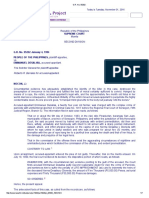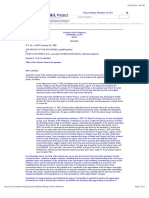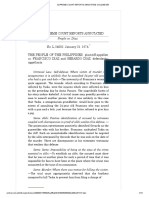People Vs Devera
People Vs Devera
Uploaded by
Affle John LeonorCopyright:
Available Formats
People Vs Devera
People Vs Devera
Uploaded by
Affle John LeonorOriginal Title
Copyright
Available Formats
Share this document
Did you find this document useful?
Is this content inappropriate?
Copyright:
Available Formats
People Vs Devera
People Vs Devera
Uploaded by
Affle John LeonorCopyright:
Available Formats
Affle John L.
Leonor
PEOPLE OF THE PHILIPPINES vs. EDWIN DE VERA y GARCIA, RODERICK
GARCIA y GALAMGAM, KENNETH FLORENDO and ELMER CASTRO
G.R. No. 128966
Ponente: Justice Panganiban
Date of Promulgation: August 18, 1999
FACTS:
About 1:30 in the afternoon of June 8, 1992, a car driven by Frederick Capulong
together with four (4) other passengers passed by at Filinvest II. Two of the passengers
were identified as Kenneth Florendo and Roderick Garcia. As it was cruising around
Denver Loop Street, a circular road whose entrance and exit were through the same
point unintelligible voices coming from the car was heard. The car parked. Moments
later, Capulong was dragged out of the car by Florendo and brought to a grassy place.
Florendo was holding a gun. Upon reaching the grassy spot, Florendo aimed and fired
the gun at the victim, with the use of a .22 cal. with trade mark "Paspar Armas" bearing
SN-29069 with five (5) pieces of caliber 22 ammo inside and a .32 cal. firearm of still
undetermined make, hitting him between his eyes and striking him with the use of a
baseball bat in the mouth, thereby inflicting upon him serious and mortal wounds which
were the direct and immediate cause of his untimely death. After the shooting, Florendo
and his companions fled in different directions. Following the investigation, the
policemen brought the suspects to the Philippine National Police Crime Laboratory for
paraffin testing. The result: "both hands of Edwin de Vera gave positive results in the
test for gunpowder nitrates while both hands of Roderick Garcia gave negative result in
the test for gunpowder nitrates."
De Vera claims that he had no part in the killing, and that it was Kenneth Florendo who
had shot the victim. He avers that he merely accompanied to Filinvest the other
accused and Florendo, who was his friend, upon the latter's request. A few hours after
the shooting incident, appellant was picked up by the police, who subsequently tortured
and coerced him into signing his Statement regarding the incident. Surveillance and
follow-up operations were conducted against Florendo and his other companion, Elmer
Castro. However, the two were never arrested and brought to trial.
The trial court found that the killing was attended by treachery, evident premeditation
and abuse of superior strength.. Edwin De Vera, Roderick Garcia, Kenneth Florendo
and Elmer Castro were charged with murder.
ISSUES:
Whether Edwin De Vera a conspirator or an accomplice?
RULING:
The Court held that De Vera presence was not innocuous. Knowing that Florendo
intended to kill the victim and that the three co-accused were carrying weapons, he had
acted as a lookout to watch for passersby. He was not an innocent spectator; he was at
the locus criminis in order to aid and abet the commission of the crime. These facts,
however, did not make him a conspirator; at most, he was only an accomplice. To hold
a person liable as an accomplice, two elements must be present: (1) the "community" of
criminal design; that is, knowing the criminal design of the principal by direct
participation, he concurs with the latter in his purpose;" and (2) the performance of
previous or simultaneous acts that are not indispensable to the commission of the
crime. Conspirators and accomplices have one thing in common: they know and agree
with the criminal design. Conspirators, however, know the criminal intention because
they themselves have decided upon such course of action. Accomplices come to know
about it after the principals have reached the decision, and only then do they agree to
cooperate in its execution. Conspirators decide that a crime should be committed;
accomplices merely concur in it. Accomplices do not decide whether the crime should
be committed; they merely assent to the plan and cooperate in its accomplishment.
Conspirators are the authors of a crime; accomplices are merely their instruments who
perform acts not essential to the perpetration of the offense. The Court ruled that there
is only one generic aggravating circumstance, because treachery absorbs abuse of
superior strength.
You might also like
- Exam - Introduction To World Religions and Belief SystemsDocument2 pagesExam - Introduction To World Religions and Belief SystemsJn Cn96% (50)
- Ditch Witch JT1720 - Parts ManualDocument231 pagesDitch Witch JT1720 - Parts Manualkingtux4561100% (2)
- Legal Medicine - Atty. OlarteDocument15 pagesLegal Medicine - Atty. OlarteIsay Sarmiento100% (3)
- Go First - Airline Tickets and Fares - Boarding PassDocument2 pagesGo First - Airline Tickets and Fares - Boarding PassShaikh RoshanNo ratings yet
- FADocument8 pagesFACassandra AnneNo ratings yet
- Canta vs. People G.R. No. 140937Document7 pagesCanta vs. People G.R. No. 140937Gendale Am-isNo ratings yet
- II People Vs Formigones DDocument2 pagesII People Vs Formigones DMargo GreenNo ratings yet
- Crim Law Case Digest JEMAA PDFDocument18 pagesCrim Law Case Digest JEMAA PDFCess LamsinNo ratings yet
- Urbano v. I.A.C. G.R. No. 72964, January 7, 1988Document1 pageUrbano v. I.A.C. G.R. No. 72964, January 7, 1988Anonymous b4ycWuoIcNo ratings yet
- People Vs Dela CruzDocument2 pagesPeople Vs Dela CruzabbyNo ratings yet
- Special Complex Crime DigestsDocument3 pagesSpecial Complex Crime DigestsSapere AudeNo ratings yet
- Us Vs EduaveDocument2 pagesUs Vs EduaveJoyleen HebronNo ratings yet
- III B People Vs Pugay DDocument2 pagesIII B People Vs Pugay DMargo GreenNo ratings yet
- PPLvDoctoler Art18AccompliceDocument3 pagesPPLvDoctoler Art18AccompliceMark Paul Balao0% (1)
- BAES Vs LUTHERAN CHURCHDocument2 pagesBAES Vs LUTHERAN CHURCHLeo TumaganNo ratings yet
- US v. Manalinde, G.R. No. 5292, 28 August 1909, 14 Phil. 77Document1 pageUS v. Manalinde, G.R. No. 5292, 28 August 1909, 14 Phil. 77LawiswisNo ratings yet
- People vs. Narvaez, 121 SCRA 389, Nos. L-33466-67 April 20, 1983Document20 pagesPeople vs. Narvaez, 121 SCRA 389, Nos. L-33466-67 April 20, 1983Alexiss Mace JuradoNo ratings yet
- Criminal Law 1-Consolidated CasesDocument407 pagesCriminal Law 1-Consolidated Casesheze100% (1)
- People V Desalisa PDFDocument7 pagesPeople V Desalisa PDFNico de la PazNo ratings yet
- Garcia vs. CA G.R. No. 134730 September 18, 2000Document3 pagesGarcia vs. CA G.R. No. 134730 September 18, 2000Emrico CabahugNo ratings yet
- 12g7. Mvhateo v. LohgjuaDocument1 page12g7. Mvhateo v. Lohgjuagem baeNo ratings yet
- Crim Case DigestDocument4 pagesCrim Case DigestMicah Clark-MalinaoNo ratings yet
- Dismissing An Employee On The Ground of Pregnancy Out of WedlockDocument2 pagesDismissing An Employee On The Ground of Pregnancy Out of WedlocklhemnavalNo ratings yet
- People V Reyes G.R. No. L 30668Document3 pagesPeople V Reyes G.R. No. L 30668Cherry lawNo ratings yet
- 2019 0831 Crim Digests 3Document8 pages2019 0831 Crim Digests 3zetteNo ratings yet
- People v. Domasian Case DigestDocument2 pagesPeople v. Domasian Case DigestmimsnftNo ratings yet
- G.R. No. 130654. July 28, 1999. PEOPLE OF THE PHILIPPINES, Plaintiff Appellee, vs. EDUARDO BASIN JAVIER, Accused AppellantDocument10 pagesG.R. No. 130654. July 28, 1999. PEOPLE OF THE PHILIPPINES, Plaintiff Appellee, vs. EDUARDO BASIN JAVIER, Accused AppellantMichael RentozaNo ratings yet
- Crim - People V OyanibDocument11 pagesCrim - People V OyanibKenny HotingoyNo ratings yet
- Crimrev Case Digests 21-88Document27 pagesCrimrev Case Digests 21-88Kim Jan Navata BatecanNo ratings yet
- Case-Digest CitizenshipDocument12 pagesCase-Digest Citizenshiptingcangmy15No ratings yet
- Romualdez v. MarceloDocument2 pagesRomualdez v. MarceloJulia Camille RealNo ratings yet
- People V BalgosDocument2 pagesPeople V BalgosLyra BalitosNo ratings yet
- People v. San PedroDocument3 pagesPeople v. San PedroRe doNo ratings yet
- Criminal Law Starosta NotesDocument85 pagesCriminal Law Starosta NotesKarabo Sm'iley MokgonyanaNo ratings yet
- (CD) US Vs Manalinde - G.R. No. 5292 - AZapantaDocument2 pages(CD) US Vs Manalinde - G.R. No. 5292 - AZapantaThe Concerned LawstudentNo ratings yet
- People Vs CampuhanDocument2 pagesPeople Vs CampuhanFrancis Coronel Jr.No ratings yet
- G.R. No. 96444Document4 pagesG.R. No. 96444AliyahDazaSandersNo ratings yet
- G.R. No. 230222, June 22, 2020 PROPER CRIME TO BE CHARGED AND PENALTYDocument12 pagesG.R. No. 230222, June 22, 2020 PROPER CRIME TO BE CHARGED AND PENALTYVNo ratings yet
- People Vs GonzalesDocument2 pagesPeople Vs GonzalesTaJheng Barde100% (1)
- Geluz Vs CA and Lazo DigestDocument2 pagesGeluz Vs CA and Lazo DigestErikha AranetaNo ratings yet
- DigestedDocument7 pagesDigestedkalumyari100% (3)
- AggravatingCircumstances CaseDigests11Document53 pagesAggravatingCircumstances CaseDigests11Nasrifah LangcoNo ratings yet
- A Philosophy of A Penal CodeDocument18 pagesA Philosophy of A Penal CodeNath AntonioNo ratings yet
- People V Tabije, No. L-36099Document3 pagesPeople V Tabije, No. L-36099Eileithyia Selene SidorovNo ratings yet
- People v. ElijordeDocument2 pagesPeople v. ElijordeSamantha Ann T. TirthdasNo ratings yet
- 70 - People V Bandian, GR No. 45186, 1936Document1 page70 - People V Bandian, GR No. 45186, 1936Judel MatiasNo ratings yet
- Bacabac VS PeopleDocument1 pageBacabac VS Peoplekent babsNo ratings yet
- People v. GuillenDocument1 pagePeople v. GuillenLansingNo ratings yet
- Gamboa v. CADocument4 pagesGamboa v. CANeil Subac100% (1)
- Urbano V CADocument1 pageUrbano V CAChello Miranda BalagsoNo ratings yet
- Article 14 and 15 CRIMDocument124 pagesArticle 14 and 15 CRIMLeeanji GalamgamNo ratings yet
- CD - People V BulanDocument4 pagesCD - People V BulanKarie SantiNo ratings yet
- People v. Diaz PDFDocument13 pagesPeople v. Diaz PDFMIKKONo ratings yet
- Political Law Review Cases 2017Document2 pagesPolitical Law Review Cases 2017Dennis De Belen MambilNo ratings yet
- Republic of The Philippines: Form 5-SccDocument2 pagesRepublic of The Philippines: Form 5-SccSergie Florague0% (1)
- Velasco V People GR No. 166479Document2 pagesVelasco V People GR No. 166479Duko Alcala EnjambreNo ratings yet
- Ient V. Tullet Prebon G.R. No. 189158, January 11, 2017 Sereno, C.J: FactsDocument24 pagesIent V. Tullet Prebon G.R. No. 189158, January 11, 2017 Sereno, C.J: FactsSTEPHEN NIKOLAI CRISANGNo ratings yet
- Philippine Jurisprudence 60Document6 pagesPhilippine Jurisprudence 60al gulNo ratings yet
- Criminal Law Case Digests PDFDocument10 pagesCriminal Law Case Digests PDFCabaron Jose GabrielNo ratings yet
- People Vs HugoDocument2 pagesPeople Vs HugoGretchen Dominguez-ZaldivarNo ratings yet
- People V MalibiranDocument5 pagesPeople V MalibiranIsabela AlgarmeNo ratings yet
- People vs. PajaresDocument1 pagePeople vs. PajaresDanielleNo ratings yet
- People Vs de VeraDocument8 pagesPeople Vs de Veraeunice demaclidNo ratings yet
- CRV6 CasDocument47 pagesCRV6 CasAndielNo ratings yet
- Criminal Law Cases On Art 16-45Document55 pagesCriminal Law Cases On Art 16-45kaiaceegeesNo ratings yet
- People Vs BayotasDocument1 pagePeople Vs BayotasAffle John Leonor100% (1)
- Norma Dizon-Pamintuan vs. People of The PhilippinesDocument4 pagesNorma Dizon-Pamintuan vs. People of The PhilippinesAffle John LeonorNo ratings yet
- People of The Philippines Vs Policarpio RafananDocument1 pagePeople of The Philippines Vs Policarpio RafananAffle John LeonorNo ratings yet
- Maula vs. Ximex, GR No. 207838, January 25, 2017Document1 pageMaula vs. Ximex, GR No. 207838, January 25, 2017Affle John Leonor100% (1)
- Construction of Each StatuteDocument9 pagesConstruction of Each StatuteAffle John LeonorNo ratings yet
- Date: 7 September 2020 Course Requirement No. 1 Coverage: Chapters 1 - 5, Political Law by Isagani Cruz I. Individual Term Paper No. 1 InstructionsDocument1 pageDate: 7 September 2020 Course Requirement No. 1 Coverage: Chapters 1 - 5, Political Law by Isagani Cruz I. Individual Term Paper No. 1 InstructionsAffle John LeonorNo ratings yet
- Philippine Legal ResearchDocument44 pagesPhilippine Legal ResearchAffle John LeonorNo ratings yet
- Leonor, Affle JohnDocument1 pageLeonor, Affle JohnAffle John LeonorNo ratings yet
- Persons Outline 1Document3 pagesPersons Outline 1Affle John LeonorNo ratings yet
- Assignment For Crimlaw 1Document4 pagesAssignment For Crimlaw 1Affle John LeonorNo ratings yet
- 2:14-cv-02518 #67Document8 pages2:14-cv-02518 #67Equality Case FilesNo ratings yet
- US ITC Samsung V Apple (No. 337-TA-794) NoticeDocument3 pagesUS ITC Samsung V Apple (No. 337-TA-794) Noticenb_fanNo ratings yet
- Brief Summary AP Solar + Storage 1MWDocument4 pagesBrief Summary AP Solar + Storage 1MWManohar PotnuruNo ratings yet
- Domingo v. Scheer, 421 SCRA 468Document16 pagesDomingo v. Scheer, 421 SCRA 468Jumen Gamaru TamayoNo ratings yet
- Ebb ConsentDocument3 pagesEbb ConsentKaren SteenNo ratings yet
- Mortgage Brokers Email ListDocument9 pagesMortgage Brokers Email Listvishal itankarNo ratings yet
- Building Over Drainage Easements PolicyDocument10 pagesBuilding Over Drainage Easements PolicyTanmay VegadNo ratings yet
- Engineers Can Play Greater Role in Solving Challenges: PrezDocument1 pageEngineers Can Play Greater Role in Solving Challenges: PrezSparsh DubeyNo ratings yet
- Adelman - Socialism and Democracy in ArgentinaDocument29 pagesAdelman - Socialism and Democracy in ArgentinaFernando Manuel SuárezNo ratings yet
- Gagan Pal Pasricha 138 Second CaseDocument30 pagesGagan Pal Pasricha 138 Second Casemanojsharma.mkrcNo ratings yet
- Bhagi Rathi Pandey: Page 1 of 3Document3 pagesBhagi Rathi Pandey: Page 1 of 3Bhagirathi PandeyNo ratings yet
- (Red Is False) : Chapter 8: RIT-Exclusions From Gross Income True or False 1Document12 pages(Red Is False) : Chapter 8: RIT-Exclusions From Gross Income True or False 1Karla Cathrina FernandoNo ratings yet
- 20 Me 128Document31 pages20 Me 128NEWS CENTER MaineNo ratings yet
- Cyber Security RefreshDocument18 pagesCyber Security RefreshStuff NewsroomNo ratings yet
- Death Penalty EssayDocument3 pagesDeath Penalty EssayjoselleNo ratings yet
- MBS FormDocument1 pageMBS Formcmog adjutantNo ratings yet
- Rapid Response Team Meeting Minutes August 6Document8 pagesRapid Response Team Meeting Minutes August 6CKNW980No ratings yet
- Former Lipscomb Police Chief Sues Mayor, Council - AlDocument1 pageFormer Lipscomb Police Chief Sues Mayor, Council - AlKira FonteneauNo ratings yet
- The Drugs (Control) Act, 1950Document3 pagesThe Drugs (Control) Act, 1950Leo Lukose100% (2)
- Proposal For Outdoor AdvertisingDocument11 pagesProposal For Outdoor AdvertisingbnmjgcNo ratings yet
- Final Accounts NotesDocument6 pagesFinal Accounts NotesVinay K TanguturNo ratings yet
- Humberto Basco Vs Philippine Amusements and Gaming Corporation-Reader PDFDocument4 pagesHumberto Basco Vs Philippine Amusements and Gaming Corporation-Reader PDFJay Dimakuta MacarambonNo ratings yet
- Instructions For CA-4 Examination (EVEN 2024)Document2 pagesInstructions For CA-4 Examination (EVEN 2024)raajveerraj785No ratings yet
- Cases On Criminal LawDocument191 pagesCases On Criminal LawMadz LunieNo ratings yet
- Labor Standards Law 1 Semester, 2020-2021 Atty. Raidah M. Mangantulao Assignments For September 21, 2020 5:30-8:30PMDocument3 pagesLabor Standards Law 1 Semester, 2020-2021 Atty. Raidah M. Mangantulao Assignments For September 21, 2020 5:30-8:30PMEsmeralda De GuzmanNo ratings yet



































































































